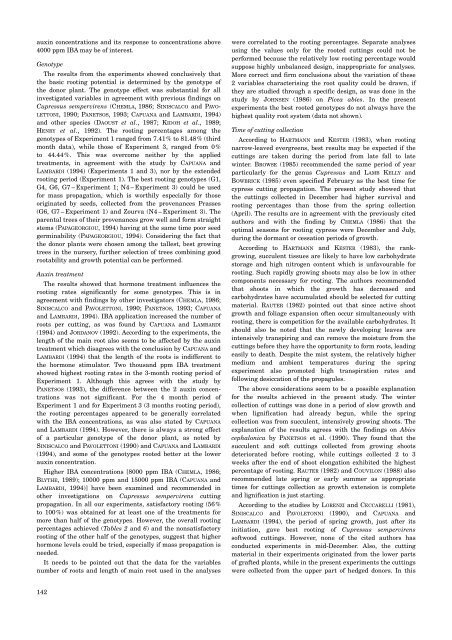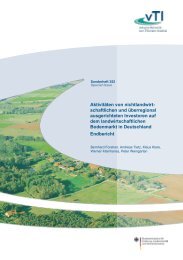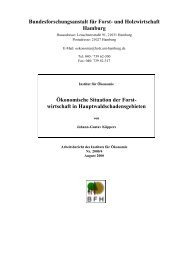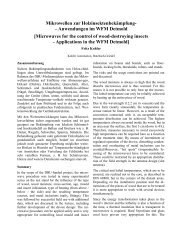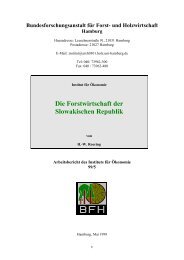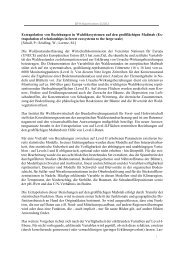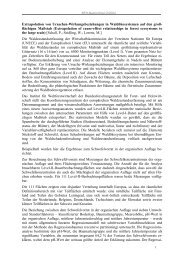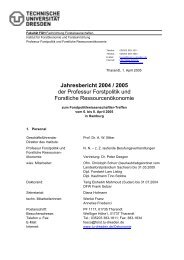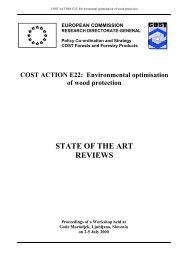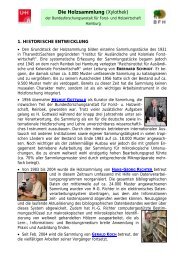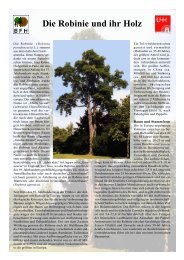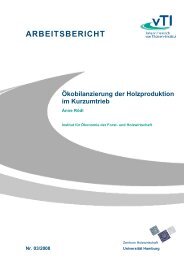Vegetative Propagation of Cupressus sempervirens
Vegetative Propagation of Cupressus sempervirens
Vegetative Propagation of Cupressus sempervirens
Create successful ePaper yourself
Turn your PDF publications into a flip-book with our unique Google optimized e-Paper software.
auxin concentrations and its response to concentrations above<br />
4000 ppm IBA may be <strong>of</strong> interest.<br />
Genotype<br />
The results from the experiments showed conclusively that<br />
the basic rooting potential is determined by the genotype <strong>of</strong><br />
the donor plant. The genotype effect was substantial for all<br />
investigated variables in agreement with previous findings on<br />
<strong>Cupressus</strong> <strong>sempervirens</strong> (CHEMLA, 1986; SINISCALCO and PAVO-<br />
LETTONI, 1990; PANETSOS, 1993; CAPUANA and LAMBARDI, 1994)<br />
and other species (DAOUST et al., 1987; KIDOH et al., 1989;<br />
HENRY et al., 1992). The rooting percentages among the<br />
genotypes <strong>of</strong> Experiment 1 ranged from 7.41% to 81.48% (third<br />
month data), while those <strong>of</strong> Experiment 3, ranged from 0%<br />
to 44.44%. This was overcome neither by the applied<br />
treatments, in agreement with the study by CAPUANA and<br />
LAMBARDI (1994) (Experiments 1 and 3), nor by the extended<br />
rooting period (Experiment 1). The best rooting genotypes (G1,<br />
G4, G6, G7 – Experiment 1; N4 – Experiment 3) could be used<br />
for mass propagation, which is worthily especially for those<br />
originated by seeds, collected from the provenances Prasses<br />
(G6, G7 – Experiment 1) and Zourva (N4 – Experiment 3). The<br />
parental trees <strong>of</strong> their provenances grow well and form straight<br />
stems (PAPAGEORGIOU, 1994) having at the same time poor seed<br />
germinability (PAPAGEORGIOU, 1994). Considering the fact that<br />
the donor plants were chosen among the tallest, best growing<br />
trees in the nursery, further selection <strong>of</strong> trees combining good<br />
rootability and growth potential can be performed.<br />
Auxin treatment<br />
The results showed that hormone treatment influences the<br />
rooting rates significantly for some genotypes. This is in<br />
agreement with findings by other investigators (CHEMLA, 1986;<br />
SINISCALCO and PAVOLETTONI, 1990; PANETSOS, 1993; CAPUANA<br />
and LAMBARDI, 1994). IBA application increased the number <strong>of</strong><br />
roots per cutting, as was found by CAPUANA and LAMBARDI<br />
(1994) and JORDANOV (1992). According to the experiments, the<br />
length <strong>of</strong> the main root also seems to be affected by the auxin<br />
treatment which disagrees with the conclusion by CAPUANA and<br />
LAMBARDI (1994) that the length <strong>of</strong> the roots is indifferent to<br />
the hormone stimulator. Two thousand ppm IBA treatment<br />
showed highest rooting rates in the 3-month rooting period <strong>of</strong><br />
Experiment 1. Although this agrees with the study by<br />
PANETSOS (1993), the difference between the 2 auxin concentrations<br />
was not significant. For the 4 month period <strong>of</strong><br />
Experiment 1 and for Experiment 3 (3 months rooting period),<br />
the rooting percentages appeared to be generally correlated<br />
with the IBA concentrations, as was also stated by CAPUANA<br />
and LAMBARDI (1994). However, there is always a strong effect<br />
<strong>of</strong> a particular genotype <strong>of</strong> the donor plant, as noted by<br />
SINISCALCO and PAVOLETTONI (1990) and CAPUANA and LAMBARDI<br />
(1994), and some <strong>of</strong> the genotypes rooted better at the lower<br />
auxin concentration.<br />
Higher IBA concentrations [8000 ppm IBA (CHEMLA, 1986;<br />
BLYTHE, 1989); 10000 ppm and 15000 ppm IBA (CAPUANA and<br />
LAMBARDI, 1994)] have been examined and recommended in<br />
other investigations on <strong>Cupressus</strong> <strong>sempervirens</strong> cutting<br />
propagation. In all our experiments, satisfactory rooting (56%<br />
to 100%) was obtained for at least one <strong>of</strong> the treatments for<br />
more than half <strong>of</strong> the genotypes. However, the overall rooting<br />
percentages achieved (Tables 2 and 6) and the nonsatisfactory<br />
rooting <strong>of</strong> the other half <strong>of</strong> the genotypes, suggest that higher<br />
hormone levels could be tried, especially if mass propagation is<br />
needed.<br />
It needs to be pointed out that the data for the variables<br />
number <strong>of</strong> roots and length <strong>of</strong> main root used in the analyses<br />
142<br />
were correlated to the rooting percentages. Separate analyses<br />
using the values only for the rooted cuttings could not be<br />
performed because the relatively low rooting percentage would<br />
suppose highly unbalanced design, inappropriate for analyses.<br />
More correct and firm conclusions about the variation <strong>of</strong> these<br />
2 variables characterising the root quality could be drawn, if<br />
they are studied through a specific design, as was done in the<br />
study by JOHNSEN (1986) on Picea abies. In the present<br />
experiments the best rooted genotypes do not always have the<br />
highest quality root system (data not shown).<br />
Time <strong>of</strong> cutting collection<br />
According to HARTMANN and KESTER (1983), when rooting<br />
narrow-leaved evergreens, best results may be expected if the<br />
cuttings are taken during the period from late fall to late<br />
winter. BROWSE (1985) recommended the same period <strong>of</strong> year<br />
particularly for the genus <strong>Cupressus</strong> and LAMB KELLY and<br />
BOWBRICK (1985) even specified February as the best time for<br />
cypress cutting propagation. The present study showed that<br />
the cuttings collected in December had higher survival and<br />
rooting percentages than those from the spring collection<br />
(April). The results are in agreement with the previously cited<br />
authors and with the finding by CHEMLA (1986) that the<br />
optimal seasons for rooting cypress were December and July,<br />
during the dormant or cessation periods <strong>of</strong> growth.<br />
According to HARTMANN and KESTER (1983), the rankgrowing,<br />
succulent tissues are likely to have low carbohydrate<br />
storage and high nitrogen content which is unfavourable for<br />
rooting. Such rapidly growing shoots may also be low in other<br />
components necessary for rooting. The authors recommended<br />
that shoots in which the growth has decreased and<br />
carbohydrates have accumulated should be selected for cutting<br />
material. RAUTER (1982) pointed out that since active shoot<br />
growth and foliage expansion <strong>of</strong>ten occur simultaneously with<br />
rooting, there is competition for the available carbohydrates. It<br />
should also be noted that the newly developing leaves are<br />
intensively transpiring and can remove the moisture from the<br />
cuttings before they have the opportunity to form roots, leading<br />
easily to death. Despite the mist system, the relatively higher<br />
medium and ambient temperatures during the spring<br />
experiment also promoted high transpiration rates and<br />
following desiccation <strong>of</strong> the propagules.<br />
The above considerations seem to be a possible explanation<br />
for the results achieved in the present study. The winter<br />
collection <strong>of</strong> cuttings was done in a period <strong>of</strong> slow growth and<br />
when lignification had already begun, while the spring<br />
collection was from succulent, intensively growing shoots. The<br />
explanation <strong>of</strong> the results agrees with the findings on Abies<br />
cephalonica by PANETSOS et al. (1990). They found that the<br />
succulent and s<strong>of</strong>t cuttings collected from growing shoots<br />
deteriorated before rooting, while cuttings collected 2 to 3<br />
weeks after the end <strong>of</strong> shoot elongation exhibited the highest<br />
percentage <strong>of</strong> rooting. RAUTER (1982) and COUVILON (1988) also<br />
recommended late spring or early summer as appropriate<br />
times for cuttings collection as growth extension is complete<br />
and lignification is just starting.<br />
According to the studies by LORENZI and CECCARELLI (1981),<br />
SINISCALCO and PAVOLETONNI (1990), and CAPUANA and<br />
LAMBARDI (1994), the period <strong>of</strong> spring growth, just after its<br />
initiation, gave best rooting <strong>of</strong> <strong>Cupressus</strong> <strong>sempervirens</strong><br />
s<strong>of</strong>twood cuttings. However, none <strong>of</strong> the cited authors has<br />
conducted experiments in mid-December. Also, the cutting<br />
material in their experiments originated from the lower parts<br />
<strong>of</strong> grafted plants, while in the present experiments the cuttings<br />
were collected from the upper part <strong>of</strong> hedged donors. In this


